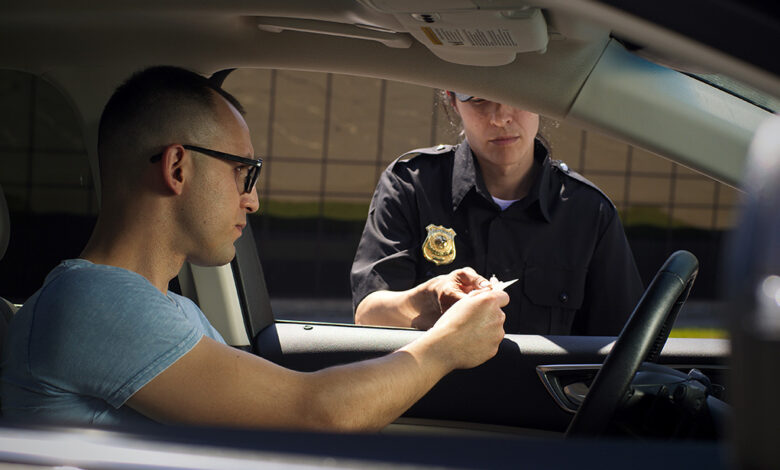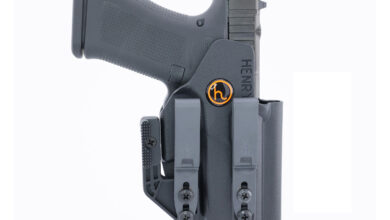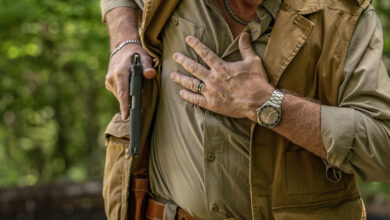Interacting With Law Enforcement While Armed

What’s the right way to interact with law enforcement while carrying a concealed firearm? Here we look at lessons from two experts.
At the 2025 NRA Annual Meeting in Atlanta, the intersection of armed citizenship and law enforcement took center stage in several thought-provoking conversations. Two voices stood out for their unique insights: Jacob Paulsen, president of ConcealedCarry.com, and Glen Hoyer, director of the NRA’s Law Enforcement Division. Together, they offered a compelling look at how armed citizens can better navigate encounters with law enforcement—rooted in data and training.
Paulsen’s perspective is grounded in hard numbers. His recent article, “What Over 1,600 Armed Traffic Stops Reveal About Law Enforcement Interactions,” dives into a dataset from 560 survey participants who collectively reported over 1,600 armed traffic stops. What the data revealed was as surprising as it was instructive.
First Key Finding: Disarmament Is Rare
Contrary to popular belief—and Paulsen’s own frequent experiences in Utah—most traffic stops involving legally armed citizens do not result in the officer disarming the individual. In fact, disarmament occurred in only about 10 percent of the stops reported. This suggests that most law enforcement officers are comfortable leaving an armed citizen’s firearm in its holster—so long as the interaction is calm, professional and safe.
Interestingly, in nearly 20 percent of those rare disarmament cases, officers asked the citizen to hand over the firearm—an approach both Paulsen and law enforcement experts strongly discourage. “The safest thing you can do,” Paulsen advises, “is refuse politely and say, ‘Officer, I’m not comfortable handling my gun in front of you. You’re welcome to retrieve it if needed.’” It’s advice echoed by tactical trainers and police alike, who understand how easily such a request could escalate into a deadly misunderstanding.
Second Key Finding: Know Your Duty to Inform—And When Not To
Another critical area of confusion involves whether an armed citizen is legally required to inform the officer that they are carrying. Paulsen’s survey revealed that about 21 percent of respondents were incorrect about their state’s laws on this matter—sometimes believing they had no duty to inform when, in fact, they did, which can carry legal consequences.
Paulsen’s takeaway: Know your state’s laws cold. But beyond legal requirements, there’s also a tactical consideration. Does the officer already know? In some states, running a driver’s license automatically reveals whether the person has a concealed carry permit. In such cases, failing to disclose may appear deceptive. “If the computer is going to tell them,” Paulsen said, “you want it to come from you, not the screen.”
Third Key Finding: Be Smart About How You Inform
If you do choose—or are required—to inform an officer that you’re armed, Paulsen and Hoyer both stress the importance of how you do it. Reaching into your glovebox or pockets as the officer approaches is a surefire way to raise alarm. Instead, roll down your window, keep your hands on the wheel and clearly state, “Officer, I have a concealed carry permit, and I am armed. How would you like me to proceed?”
This kind of approach, Paulsen argues, is especially important because traffic stops are high-stress situations—for both parties. “Practice what you’ll say before it happens,” he advised. “And be very specific if asked where your firearm is—say, ‘It’s in a holster at my 4 o’clock position on my belt,’ not ‘It’s back here somewhere.’”
Glen Hoyer’s Law Enforcement Perspective
From the other side of the badge, Glen Hoyer emphasized the same principles—but added context from decades of police experience. His message was clear: law enforcement officers don’t know who you are during a stop. Whether you’re a good guy or not, you’re a potential threat until proven otherwise.
In fact, Hoyer opens his discussion by pointing out how even uniformed officers sometimes mistakenly shoot undercover or off-duty cops. “If we can’t always identify our own,” he noted, “we certainly can’t assume that a civilian with a gun is a good guy.”
That’s why body language and demeanor matter. Hoyer recommends turning on your dome light during nighttime stops, keeping your hands palm-up on the steering wheel, and ensuring that passengers do the same. “It communicates cooperation. You’re showing us, before we even say a word, that you mean no harm.”
Training, Scripting and Recording
Both experts also addressed a topic often overlooked: what to do if things start going sideways. If you’re being asked to do something that raises red flags—like handing over your gun—Hoyer and Paulsen agree: Ask for a supervisor. “Every patrol shift has one,” Paulsen noted. “Don’t be afraid to make that request if you feel unsafe or uncertain.”
Recording the encounter is also fair game. In most states, single-party consent laws allow you to legally record interactions with law enforcement. “You don’t need to announce it,” Paulsen said, “but having a record could be invaluable if something goes wrong.”
Final Takeaway: It’s Not About Winning the Encounter
Perhaps the most important lesson is this: your goal during a traffic stop—or any interaction with police—is not to “win.” It’s to make sure everyone goes home safe. That means thinking ahead, knowing your rights and responsibilities, and approaching the moment with humility and clarity.
As both Paulsen and Hoyer made clear at the NRA Annual Meeting, being an armed citizen comes with weighty responsibility. But with the right mindset, training and preparation, these interactions don’t have to be tense or dangerous—they can be just another example of what respectful civic engagement looks like.
Editor’s Note: This article originally appeared in the July 2025 issue of Gun Digest the Magazine.
More Knowledge For The Armed Citizen:

Next Step: Get your FREE Printable Target Pack
Enhance your shooting precision with our 62 MOA Targets, perfect for rifles and handguns. Crafted in collaboration with Storm Tactical for accuracy and versatility.
Subscribe to the Gun Digest email newsletter and get your downloadable target pack sent straight to your inbox. Stay updated with the latest firearms info in the industry.
Read the full article here





![EOTECH Vudu 3-9×32 [RECOILTV] | RECOIL EOTECH Vudu 3-9×32 [RECOILTV] | RECOIL](https://firearm-discounts.com/wp-content/uploads/2025/09/Iain-EOTech-3-to-9-390x220.png)


